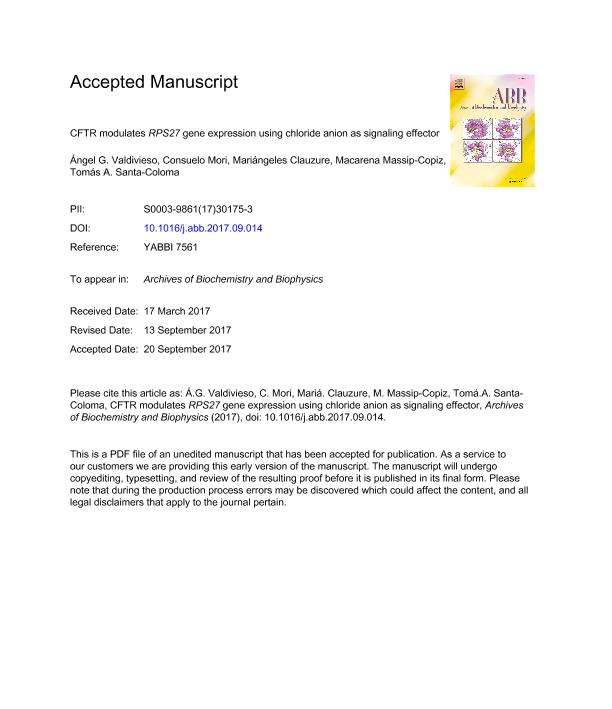Artículo
CFTR modulates RPS27 gene expression using chloride anion as signaling effector
Valdivieso, Ángel Gabriel ; Mori, Consuelo
; Mori, Consuelo ; Clauzure, Mariangeles
; Clauzure, Mariangeles ; Massip Copiz, María Macarena
; Massip Copiz, María Macarena ; Santa Coloma, Tomás Antonio
; Santa Coloma, Tomás Antonio
 ; Mori, Consuelo
; Mori, Consuelo ; Clauzure, Mariangeles
; Clauzure, Mariangeles ; Massip Copiz, María Macarena
; Massip Copiz, María Macarena ; Santa Coloma, Tomás Antonio
; Santa Coloma, Tomás Antonio
Fecha de publicación:
09/2017
Editorial:
Elsevier Science Inc
Revista:
Archives of Biochemistry and Biophysics
ISSN:
0003-9861
Idioma:
Inglés
Tipo de recurso:
Artículo publicado
Clasificación temática:
Resumen
In Cystic Fibrosis (CF), the impairment of the CFTR channel activity leads to a variety of alterations, including differential gene expression. However, the CFTR signaling mechanisms remain unclear. Recently, culturing IB3-1 CF cells under different intracellular Cl− concentrations ([Cl−]i), we observed several Cl−-dependent genes and further characterized one of them as RPS27. Thus, we hypothesized that Cl− might act as a signaling effector for CFTR signaling. Here, to test this idea, we study RPS27 expression in T84 cells modulating the CFTR activity by using CFTR inhibitors. First, we observed that incubation of T84 cells with increasing concentrations of the CFTR inhibitors CFTR(inh)-172 or GlyH-101 determined a progressive increase in the relative [Cl−]i (using the Cl− fluorescent probe SPQ). The [Cl−]i rise was concomitant with a dose-dependent down-regulation of RPS27. These results imply that CFTR inhibition produce Cl− accumulation and that RPS27 expression can be modulated by CFTR inhibition. Therefore, Cl− behaves as a signaling effector for CFTR in the modulation of RPS27 expression. In addition, the IL-1β receptor antagonist IL1RN or the JNK inhibitor SP600125, both restored the down-regulation of RPS27 induced by CFTRinh-172, implying a role of autocrine IL-1β and JNK signaling downstream of Cl− in RPS27 modulation.
Palabras clave:
Cftr
,
Rps27
,
Chloride
,
Signaling Effector
,
Il-1β
,
Jnk
,
Autocrine
,
Il-1β Loop
,
Il1rn
,
Sp600125
Archivos asociados
Licencia
Identificadores
Colecciones
Articulos(OCA HOUSSAY)
Articulos de OFICINA DE COORDINACION ADMINISTRATIVA HOUSSAY
Articulos de OFICINA DE COORDINACION ADMINISTRATIVA HOUSSAY
Citación
Valdivieso, Ángel Gabriel; Mori, Consuelo; Clauzure, Mariangeles; Massip Copiz, María Macarena; Santa Coloma, Tomás Antonio; CFTR modulates RPS27 gene expression using chloride anion as signaling effector; Elsevier Science Inc; Archives of Biochemistry and Biophysics; 633; 9-2017; 103-109
Compartir
Altmétricas



